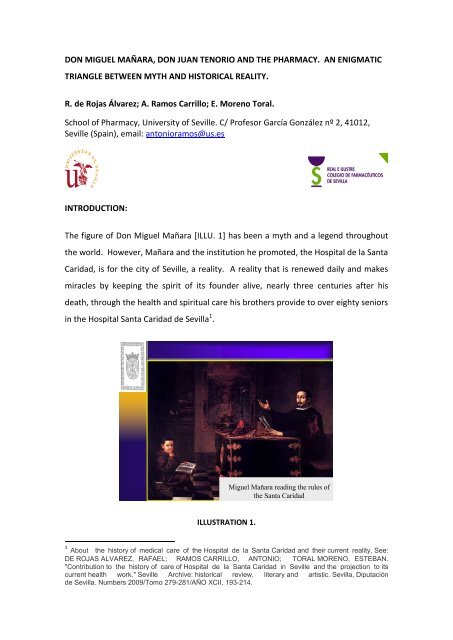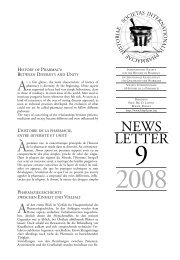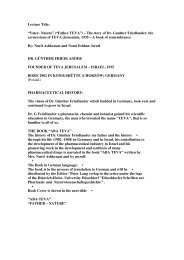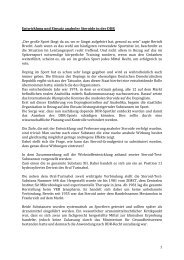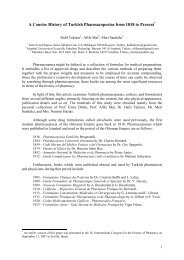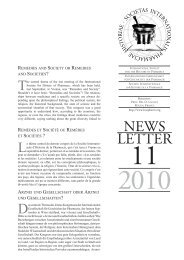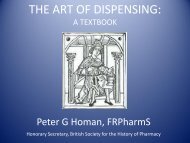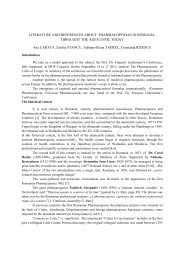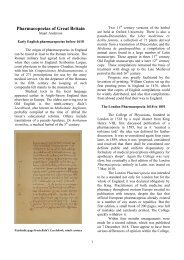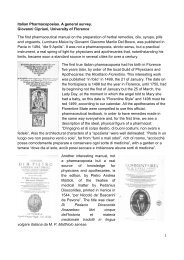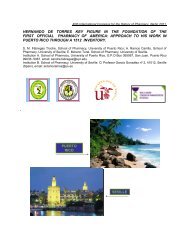don miguel mañara, don juan tenorio and the pharmacy
don miguel mañara, don juan tenorio and the pharmacy
don miguel mañara, don juan tenorio and the pharmacy
You also want an ePaper? Increase the reach of your titles
YUMPU automatically turns print PDFs into web optimized ePapers that Google loves.
DON MIGUEL MAÑARA, DON JUAN TENORIO AND THE PHARMACY. AN ENIGMATIC<br />
TRIANGLE BETWEEN MYTH AND HISTORICAL REALITY.<br />
R. de Rojas Álvarez; A. Ramos Carrillo; E. Moreno Toral.<br />
School of Pharmacy, University of Seville. C/ Profesor García González nº 2, 41012,<br />
Seville (Spain), email: antonioramos@us.es<br />
INTRODUCTION:<br />
The figure of Don Miguel Mañara [ILLU. 1] has been a myth <strong>and</strong> a legend throughout<br />
<strong>the</strong> world. However, Mañara <strong>and</strong> <strong>the</strong> institution he promoted, <strong>the</strong> Hospital de la Santa<br />
Caridad, is for <strong>the</strong> city of Seville, a reality. A reality that is renewed daily <strong>and</strong> makes<br />
miracles by keeping <strong>the</strong> spirit of its founder alive, nearly three centuries after his<br />
death, through <strong>the</strong> health <strong>and</strong> spiritual care his bro<strong>the</strong>rs provide to over eighty seniors<br />
in <strong>the</strong> Hospital Santa Caridad de Sevilla 1 .<br />
Miguel Mañara reading <strong>the</strong> rules of<br />
<strong>the</strong> Santa Caridad<br />
ILLUSTRATION 1.<br />
1 About <strong>the</strong> history of medical care of <strong>the</strong> Hospital de la Santa Caridad <strong>and</strong> <strong>the</strong>ir current reality, See:<br />
DE ROJAS ALVAREZ, RAFAEL; RAMOS CARRILLO, ANTONIO; TORAL MORENO, ESTEBAN.<br />
"Contribution to <strong>the</strong> history of care of Hospital de la Santa Caridad in Seville <strong>and</strong> <strong>the</strong> projection to its<br />
current health work." Seville Archive: historical review, literary <strong>and</strong> artistic. Sevilla, Diputación<br />
de Sevilla. Numbers 2009/Tomo 279-281/AÑO XCII, 193-214.
OBJECTIVES:<br />
We shall try to express our information in <strong>the</strong> form of a triangle, in which each vertex<br />
represents a basic pillar in <strong>the</strong> life of Mañara: History, Legend, <strong>and</strong> his contributions to<br />
Hospital Care [ILLU. 2].<br />
L<br />
E<br />
G<br />
E<br />
N<br />
D<br />
HISTORY<br />
MAÑARA<br />
H<br />
O<br />
S<br />
P<br />
I<br />
T<br />
A<br />
L<br />
C<br />
A<br />
R<br />
E<br />
ENIGMATIC TRIANGLE<br />
ILLUSTRATION 2. Enigmatic triangle.<br />
Our objective is to expose Don Miguel Mañara as a Deputy for Pharmacy Inspections in<br />
<strong>the</strong> city of Seville, <strong>and</strong> to bring international attention to this little known aspect in <strong>the</strong><br />
life of this distinguished <strong>and</strong> notable citizen of Seville.<br />
MATERIALS AND METHOD:<br />
We conducted thorough literary <strong>and</strong> document research about D. Miguel Mañara<br />
consulting [ILLU. 3], among o<strong>the</strong>r sources, <strong>the</strong> Municipal Archives in Seville <strong>and</strong> <strong>the</strong><br />
private archives of <strong>the</strong> Santa Caridad in Seville, making a critical <strong>and</strong> comparative<br />
analysis of all information found.
Documents research about D. Miguel Mañara.<br />
RESULTS:<br />
ILLUSTRATION 3. Private archives of <strong>the</strong> Santa Caridad in Seville.<br />
One of <strong>the</strong> vertexes of this hypo<strong>the</strong>tical triangle we’ve traced is that of <strong>the</strong> historical<br />
reality. Don Miguel Mañara is a unique, unrepeatable public figure, <strong>and</strong> belongs to <strong>the</strong><br />
patrimony of all those who live <strong>and</strong> work in Seville. He is unknown to a great number<br />
of Spaniards, <strong>and</strong> some know him as Don Juan Tenorio, while o<strong>the</strong>rs know him as a<br />
future Saint.<br />
One can get to know this mysterious 2 figure through <strong>the</strong> paintings which can be found<br />
in <strong>the</strong> Hospital de la Santa Caridad. Just by taking a stroll through <strong>the</strong> Sala de Cabildos<br />
del Hospital (“Town Council Ward”), one can see what is perhaps <strong>the</strong> painting that<br />
best represents him: “Don Migel leyendo la regla de la Santa Caridad” (Don Miguel<br />
reading <strong>the</strong> rules of <strong>the</strong> Santa Caridad), a work by Juan de Valdés Leal (1681) 3 .<br />
Ano<strong>the</strong>r way to get to know him is by w<strong>and</strong>ering through <strong>the</strong> city of Seville, perhaps<br />
along <strong>the</strong> street named after him, or perhaps by taking in various sculptures made of<br />
2 Curiously, Manara was buried twice, first at <strong>the</strong> explicit request in his will in <strong>the</strong> very soil of <strong>the</strong><br />
cemetery of <strong>the</strong> Church, so that everyone could step on his grave. The second, seven months after his<br />
death, he was buried in <strong>the</strong> crypt next to <strong>the</strong> altar of <strong>the</strong> Church, at <strong>the</strong> initiative of <strong>the</strong> Bro<strong>the</strong>rhood.<br />
3 For more information on <strong>the</strong> iconography of <strong>the</strong> saint Charity Hospital in Seville, see: VALDIVIESO,<br />
ENRIQUE AND Serrera, J. M. The Hospital de la Caridad in Seville. Valladolid, Editorial Server-Cuesta,<br />
1980.
him by Antonio Susillo. One is located in <strong>the</strong> Palacio San Telmo (Palace of Saint Telmo)<br />
where he is surrounded by o<strong>the</strong>r illustrious figures of Seville 4 , <strong>and</strong> ano<strong>the</strong>r is <strong>the</strong><br />
bronze statue which is located opposite <strong>the</strong> Hospital. In both cases, Mañara is<br />
represented carrying a beggar in his arms with <strong>the</strong> intention of taking him to <strong>the</strong><br />
Hospital de la Santa Caridad.<br />
Don Miguel is <strong>the</strong> ninth son of Mrs. Jerónima Anfriano <strong>and</strong> D. Thomas Manara, a<br />
wealthy merchant of Italian origin, <strong>and</strong> <strong>the</strong> holder of an immense fortune earned<br />
through his Atlantic trade. Mañara, despite being <strong>the</strong> baby of <strong>the</strong> family, would one<br />
day inherit all his fa<strong>the</strong>r's fortune, for in his short life, seven of his siblings would die (a<br />
fact which would mark him psychologically), with his sister Isabel being <strong>the</strong> only sibling<br />
to outlive him <strong>and</strong> <strong>the</strong> only one who had heirs.<br />
In 1648 two events occurred that changed his life: <strong>the</strong> death of his fa<strong>the</strong>r <strong>and</strong> his<br />
wedding, while <strong>the</strong> former precedes <strong>the</strong> latter. D. Miguel is married by proxy to a<br />
noble lady from Granada, Jéromina Carrillo de Mendoza, <strong>and</strong> <strong>the</strong> marriage would last<br />
thirteen years, though not produce any children.<br />
After <strong>the</strong> death of his wife <strong>and</strong> contrary to what many people believe, Mañara<br />
continued to work in <strong>the</strong> mercantile business 5 . After a period of reflection, he applied<br />
for membership in <strong>the</strong> Bro<strong>the</strong>rhood of Santa Caridad, one of <strong>the</strong> many bro<strong>the</strong>rhoods<br />
which existed at <strong>the</strong> time in Seville. Surprisingly, his request was rejected <strong>and</strong> would<br />
not be accepted until three months later. His attitude <strong>and</strong> work in <strong>the</strong> bro<strong>the</strong>rhood<br />
caused a radical change of opinion in <strong>the</strong> organization, for after only a year, he is<br />
elected “Hermano Mayor” (Eldest Bro<strong>the</strong>r). As such, he encouraged <strong>the</strong> construction<br />
of <strong>the</strong> Church that <strong>the</strong> Bro<strong>the</strong>rhood was building <strong>and</strong> founded a small hospice. In 1673<br />
he began <strong>the</strong> building of an infirmary, under <strong>the</strong> patronage of Jesus Christ, <strong>and</strong> four<br />
years later he began ano<strong>the</strong>r under <strong>the</strong> patronage of <strong>the</strong> Virgin Mary. A few years<br />
later, in 1678, he began <strong>the</strong> third infirmary <strong>and</strong> began construction of <strong>the</strong> courtyards<br />
4 Antonio Susillo (1857-1896) made, at <strong>the</strong> request of <strong>the</strong> Dukes of Montpensier who owned <strong>the</strong> palace<br />
of San Telmo, a series of sculptures that were located in <strong>the</strong> north facade of <strong>the</strong> palace. There we can<br />
see Mañara surrounded by <strong>the</strong> likes of Velázquez, Murillo <strong>and</strong> Daoiz.<br />
5 For more information see: Vila Vilar, Enriqueta. The Corzo <strong>and</strong> Mañara: types <strong>and</strong> archetypes of <strong>the</strong><br />
merchant with <strong>the</strong> Indies. Sevilla, Escuela de Estudios Hispano-Americanos, 1991.
that will definitively form <strong>the</strong> Hospital de la Santa Caridad. Mañara most likely died of<br />
typhus in <strong>the</strong> hospital he founded on May 9, 1679, after having written two books,<br />
"The discourse of truth" <strong>and</strong> new rules he drafted for <strong>the</strong> bro<strong>the</strong>rhood in 1675.<br />
Ano<strong>the</strong>r vertex of this triangle is <strong>the</strong> legend that surrounds him. D. Miguel was born in<br />
Seville in 1627, years later <strong>the</strong> works of Tirso de Molina, "The Trickster of Seville <strong>and</strong><br />
Stone Guest," are published which popularized <strong>and</strong> gave worldwide fame to <strong>the</strong> figure<br />
of D. Juan Tenorio. Some authors, notably <strong>the</strong> French Romantics, have tried to merge<br />
both characters into one: Mérimée, Dumas, Latour <strong>and</strong> o<strong>the</strong>rs, <strong>and</strong> more recently,<br />
Es<strong>the</strong>r Van Loo 6 (1950), depict Don Miguel from Seville as a young gentleman who<br />
assaults convents, kills <strong>the</strong> fa<strong>the</strong>r of his beloved, travels around half of Europe 7 , <strong>the</strong>n<br />
returns to Seville to repent <strong>and</strong> surrender to penance. According to <strong>the</strong>m, it is <strong>the</strong><br />
figure of Mañara <strong>and</strong> no one else which Tirso de Molina had before him when he<br />
wrote his famous tragicomedy of El Burlador de Sevilla (The Trickster of Seville). But<br />
how could he be <strong>the</strong> model for <strong>the</strong> Trickster of Seville if he was just a child at <strong>the</strong> time<br />
when <strong>the</strong> play was written?<br />
Trying to undo <strong>the</strong> "Mañara-Tenorio" binomial is relatively easy if we read Pivetau<br />
Olivier in his book Don Miguel Mañara frente al mito de D. Juan 8 ("Don Miguel Mañara<br />
versus <strong>the</strong> myth of Don Juan)" however it is a very complicated task when dealing with<br />
a layman.<br />
It is also impossible to separate Seville <strong>and</strong> Mañara; this illustrious figure left his<br />
fortune, his life <strong>and</strong> his thoughts in <strong>the</strong> Hospital de la Santa Caridad, one of <strong>the</strong> most<br />
effective charitable institutions in <strong>the</strong> whole of Seville [ILLU. 4].<br />
6 LOO, ESTHER: “Le vrai Don Juan: Miguel de Mañara” prefacio de A. Castelot. París, S.F.E.L.T., 1950.<br />
7 The historical reality shows that Mañara barely left Seville. The only documentary evidence shows he<br />
made two trips to Madrid <strong>the</strong>n at thirty years old, went to Montejaque (Málaga) to <strong>the</strong> l<strong>and</strong> of <strong>the</strong><br />
maternal family of his wife <strong>and</strong> <strong>the</strong> snowy Deserts of Snow in <strong>the</strong> Sierra de Ronda, where he went to<br />
reflect upon her death.<br />
8 PIVETEAU, OLIVIER. D. Miguel Mañara frente al mito de Don Juan. 2 volúmenes. Sevilla, Cajasol<br />
Fundación Obra Social, 2007.
HOSPITAL DE LA CARIDAD<br />
AND<br />
MIGUEL MAÑARA<br />
ILLUSTRATION 4.<br />
Although he was not <strong>the</strong> founder of <strong>the</strong> Bro<strong>the</strong>rhood, since its origin is much older<br />
than him, he endowed it with facilities <strong>and</strong> resources which exceeded its primitive<br />
functions, which were simply to bury <strong>the</strong> bones of those executed <strong>and</strong> <strong>the</strong> dead who<br />
did not have anyone to give <strong>the</strong>m a proper burial.<br />
In this decadent age of Seville, w<strong>and</strong>ering poor, needy, pimps <strong>and</strong> beggars were a<br />
normal sight, who had been attracted by <strong>the</strong> hypo<strong>the</strong>tical wealth of <strong>the</strong> city. Many fell<br />
ill without finding asylum or cures for <strong>the</strong>ir illnesses. It is Mañara who convinced <strong>the</strong><br />
Bro<strong>the</strong>rhood to exp<strong>and</strong> its hospital, creating a network of chairs to transport patients<br />
who were on <strong>the</strong> street <strong>and</strong> admitted to his own hospital those who had been rejected<br />
by o<strong>the</strong>rs 9 .<br />
Mañara did daily counts of how many times each poor needy patient roamed <strong>the</strong> city.<br />
To this end, he proposed <strong>the</strong> creation of chairs to be transport <strong>the</strong>m to <strong>the</strong> hospitals.<br />
Mañara's contribution to hospital care in Seville is truly spectacular. The result of our<br />
9 In <strong>the</strong> council of February 17, 1664 Manara proposed detailed plans to <strong>the</strong> Bro<strong>the</strong>rhood for <strong>the</strong><br />
creation of a hospital to shelter <strong>the</strong>se people. Book I of Councils <strong>and</strong> Agreements. Chapter of February<br />
17, 1664. Private Archives of <strong>the</strong> Santa Caridad in Seville.
esearch in <strong>the</strong> Archives of <strong>the</strong> Santa Caridad (ASC) can give accurate data of how<br />
many poor people were aided, with an average of almost one thous<strong>and</strong> patients<br />
transported annually 10 . The Bro<strong>the</strong>rhood buried nearly a hundred poor homeless<br />
people annually 11 who would o<strong>the</strong>rwise not have had a burial, spending a considerable<br />
amount of money on clo<strong>the</strong>s, shirts <strong>and</strong> dresses for those <strong>the</strong>y had taken in 12 , as well<br />
as purchasing bundles of firewood, charcoal, pounds of bacon, brooms <strong>and</strong> o<strong>the</strong>r<br />
utensils for <strong>the</strong> maintenance of <strong>the</strong> hospital.<br />
The Hospital de la Santa Caridad is, as <strong>the</strong> professor Carmona indicates 13 , characteristic<br />
of hospitals in <strong>the</strong> seventeenth <strong>and</strong> eighteenth centuries. It was dedicated to<br />
providing food, shelter <strong>and</strong> fire, <strong>and</strong> giving comforting spiritual assistance to those<br />
under <strong>the</strong>ir refuge, with <strong>the</strong> sole limitation of admitting only male patients. It is<br />
important to note <strong>the</strong> extensive number of needy to whom <strong>the</strong>y gave shelter <strong>and</strong><br />
support. For example, in 1672 <strong>the</strong> Hospital was home to over 3000 poor <strong>and</strong> <strong>the</strong> same<br />
amount in 1673 14 . Health care <strong>and</strong> pharmaceuticals for <strong>the</strong>se patients would be<br />
developed in later centuries, as <strong>the</strong> data collated in <strong>the</strong> ASC expenses for <strong>pharmacy</strong><br />
corroborates. These expenses are included in <strong>the</strong> extraordinary expenses of <strong>the</strong><br />
hospital <strong>and</strong> are insignificant in relation to total monthly spending 15 .<br />
10 1050 patients were transported in 1670, 1064, in 1671, 912 in 1672, 1083 in 1673, 1173 in 1674, 900<br />
in 1675, 984 in 1676, 1295, in 1677, 1350 in 1678 <strong>and</strong> 1296 in <strong>the</strong> year 1679. Summaries of <strong>the</strong> Board at<br />
<strong>the</strong> end of each year. Book I of Councils <strong>and</strong> Agreements. A.S.C.<br />
11 In 1670 <strong>the</strong>re were 95 burials, 99 in 1671, 98 in 1672, 108 in 1673, 114 in 1674, 119 in 1675, 120 in<br />
1676, 172 in 1677, 315 in 1678, <strong>and</strong> in <strong>the</strong> year 1679, a total of 353 burials. Summaries of <strong>the</strong> Board at<br />
<strong>the</strong> end of each year. Book I of Councils <strong>and</strong> Agreements. A.S.C.<br />
12 8400 reales were spent in 1672 on 600 shirts for poor, 1000 reales for 50 shirts in 1673, 18000 900<br />
reales in 1674 <strong>and</strong> 3513 shirts in shirts <strong>and</strong> dresses in 1676. Summaries of <strong>the</strong> Board at <strong>the</strong> end of each<br />
year. Book I of Councils <strong>and</strong> Agreements. A.S.C.<br />
13 CARMONA, JUAN IGNACIO. Los Hospitales en la Sevilla moderna. Sevilla, Colecciones paralelas.<br />
Publicaciones de la Excma. Diputación Provincial de Sevilla, 1980.<br />
14 This is reflected in <strong>the</strong> summaries of <strong>the</strong> Board at <strong>the</strong> end of <strong>the</strong>se years, not specifying <strong>the</strong> exact<br />
number, <strong>the</strong> figure appearing as "more than 3000." Book I of Councils <strong>and</strong> agreements. A.S.C.<br />
15 In 1686 in January 1935 reales were spent on extraordinary expenses corresponding to 18.50 only<br />
royal <strong>pharmacy</strong> expenses, in February spending on <strong>pharmacy</strong> expenses of 10.50 against a monthly cost<br />
of 1223 reales. In March, pharmaceutical expenses were 15 reales versus 1088 reales monthly. Nothing<br />
was spent on pharmaceuticals in April or May, or June, or July. In August , only two reales were spent<br />
versus 1568 actual monthly expenditure. In September 1277 reales were spent in monthly costs<br />
compared to 10 reales in pharmaceuticals. In October 20 reales versus 1130 <strong>and</strong> in November, it was 8<br />
reales in medicine versus 1235. Ultimately in December 1737 reales was spent compared to 29.50<br />
reales in monthly expenses. Total hospital spending surpassed 700,000 reales in this year.
Few things can be said of Mañara which have not already been said. This public figure,<br />
who has been elevated to <strong>the</strong> category of literary myth <strong>and</strong> declared venerable by <strong>the</strong><br />
Catholic Church, is also linked with <strong>the</strong> <strong>pharmacy</strong>. Mañara’s contributions to <strong>the</strong><br />
<strong>pharmacy</strong> are practically unknown, <strong>and</strong> for him, were probably nothing more than a<br />
footnote in his eventful life. He was a deputy for Pharmacy Inspections throughout <strong>the</strong><br />
city of Seville in 1656, <strong>and</strong> it is for <strong>the</strong> sole fact that he had been involved in<br />
pharmaceutical activity that he deserves to be recognized <strong>and</strong> proclaimed in a forum<br />
as important as <strong>the</strong> Congress of <strong>the</strong> History of Pharmacy.<br />
As a notable person in <strong>the</strong> city of Seville, Mañara was part of <strong>the</strong> Council of Seville 16 ,<br />
<strong>and</strong> fulfilled various roles in <strong>the</strong> organization throughout his life.<br />
In <strong>the</strong> Municipal Archives of Seville (AMS) <strong>and</strong> specifically in <strong>the</strong> Chapter Acts of <strong>the</strong><br />
City of Seville, we found that D. Miguel Mañara was named deputy for Pharmacy<br />
Inspections (diputado de visitas boticas) in 1656 17 . These records name all <strong>the</strong> councils<br />
in that year, naming Mañara alongside D. Domingo Ortiz <strong>and</strong> Don Francisco Melgarejo<br />
Contreras as deputy Inspectors.<br />
A new professional organization arose in Seville 1625, <strong>the</strong> College of Apo<strong>the</strong>caries of<br />
San Jose (el Colegio de Boticarios de San José), which was directly dependant on <strong>the</strong><br />
archdiocese. Charles II, by Royal Decree of December 19, 1685 <strong>and</strong> August 8, 1689<br />
allowed <strong>the</strong> archdiocese to elect <strong>the</strong> deputy Pharmacy Inspectors, <strong>and</strong> it retained this<br />
privilege until 1742 18 . As <strong>the</strong> College of Apo<strong>the</strong>caries was not allowed to choose <strong>the</strong><br />
Pharmacy Inspectors until 1685, it was Mañara in 1656 that would be thus responsible<br />
for taking on this function, if only in a purely administrative role, attesting to <strong>the</strong><br />
inspections made in <strong>the</strong> pharmacies.<br />
16 Manara was admitted t in <strong>the</strong> meeting held on July 31, 1651, "[...] swearing to God <strong>and</strong> <strong>the</strong> Cross that<br />
he would use well <strong>and</strong> faithfully this honorable <strong>and</strong> exalted position, in keeping with <strong>the</strong> Municipal<br />
taking a seat in <strong>the</strong> most modern bank of justice, next to <strong>the</strong> mayors with a voice pre-eminence of <strong>the</strong><br />
upper h<strong>and</strong> of justice in his right h<strong>and</strong> <strong>and</strong> sword at his side. "Cf: LÓPEZ MARTÍNEZ, CELESTINO:<br />
Bro<strong>the</strong>rhood of holy charity <strong>and</strong> <strong>the</strong> venerable Manara. "File of Seville," <strong>the</strong> second time No. 1 <strong>and</strong> No.<br />
2. 1943.<br />
17 Primera Escribanía. Actas Capitulares 1655 y 1656. Sección X. Libro 62. Signatura H-1661. A.M.S.<br />
18 For more information, read: PUERTO SARMIENTO, FRANCISCO JAVIER: The Myth of Panacea<br />
Compendium of History of Pharmacy <strong>and</strong> Therapeutics. Madrid, Ediciones Doce Calles SL 1997.
Therefore, <strong>the</strong> normal functioning of <strong>the</strong> pharmacies was verified through visits by way<br />
of inspection, which were made by health professionals <strong>and</strong> civil servants, sometimes<br />
administrative representatives of <strong>the</strong> municipality, which is <strong>the</strong> case of Mañara as<br />
representative of <strong>the</strong> City Council of Seville.<br />
Monitoring <strong>the</strong> practice of all members of <strong>the</strong> corporation was completed through a<br />
minimum of two inspections a year, but as many inspections as deemed appropriate<br />
could be made.<br />
For all <strong>the</strong>se reasons <strong>and</strong> with an effort of syn<strong>the</strong>sis, we can state that in 1639, Jerome<br />
de la Fuente Izcala [alias Jerome de la Fuente Pierola] acquired by Royal Decree, for<br />
12,000 ducats, <strong>and</strong> for a period of three generations, <strong>the</strong> position as "Inspector<br />
General of all <strong>the</strong> pharmacies, Drugstores, distillation <strong>and</strong> o<strong>the</strong>r Pharmacy related<br />
businesses, Medicines shops, both simple <strong>and</strong> complex, public <strong>and</strong> secret any part of<br />
<strong>the</strong> Cities, towns <strong>and</strong> villages <strong>and</strong> of Abadengo, Behetrías <strong>and</strong> Hordenes manors<br />
within <strong>the</strong> archbishop of Seville, Cordoba, Cartagena, Cadiz, Almeria <strong>and</strong> Guadix. "<br />
Later, de la Fuente Pierola resold <strong>the</strong> appointment of inspector to Seville <strong>and</strong> its<br />
Archbishop Thomas Montero de Espinosa, who would fulfill this function until 1646,<br />
when he was succeeded by <strong>the</strong> Bentura [sic] Perez Ortega, who ceased his duties as<br />
inspector of pharmacies in 1703 19 .<br />
Therefore, in 1656, Miguel Mañara would act as <strong>the</strong> municipal representative as<br />
deputy Pharmacy Inspector, <strong>and</strong> would coincide with Bentura Perez Ortega.<br />
CONCLUSIONS:<br />
D. Miguel Mañara y Vicentelo de Leca is a historical figure of undoubted importance to<br />
<strong>the</strong> city of Seville for <strong>the</strong> founding of a hospital that continues to operate today,<br />
helping <strong>the</strong> most disadvantaged in addition to being famous worldwide for his<br />
legendary connection with literature of Zorrilla <strong>and</strong> o<strong>the</strong>rs.<br />
19 LÓPEZ DÍAZ, MARÍA TERESA (prólogo): Directorio de Boticarios de Francisco de Ortega, 1625 (Edición<br />
facsímil). Sevilla, Fundación Farmacéutica Avenzoar, 1991. p 21.
We have tried to bring to light his relationship with <strong>the</strong> <strong>pharmacy</strong> in his appointment<br />
as Deputy Pharmacy Inspector in 1656 in Seville, even though <strong>the</strong> College of<br />
Apo<strong>the</strong>caries had not yet assumed <strong>the</strong> appointing of <strong>the</strong> Inspectors for those dates. His<br />
role as Deputy Pharmacy Inspector is clearly overshadowed by his undoubted historical<br />
significance, but we think this fact is important enough to record it here in <strong>the</strong>se lines.<br />
BIBLIOGRAPHY:<br />
CARMONA, JUAN IGNACIO. Los Hospitales en la Sevilla moderna. Sevilla, Colecciones<br />
paralelas. Publicaciones de la Excma. Diputación Provincial de Sevilla, 1980.<br />
DE ROJAS ÁLVAREZ, RAFAEL; RAMOS CARRILLO, ANTONIO; MORENO TORAL, ESTEBAN.<br />
“Contribución a la historia asistencial del Hospital de la Santa Caridad de Sevilla y la<br />
proyección a su actual labor sanitaria”. Archivo Hispalense: revista histórica, literaria y<br />
artística. Sevilla, Diputación de Sevilla. Números 279-281/AÑO 2009/Tomo XCII, 193-<br />
214.<br />
LÓPEZ DÍAZ, MARÍA TERESA (Prólogo a la edición facímil). Directorio de Boticarios de<br />
Francisco de Ortega, 1625 (Edición facsímil). Sevilla, Fundación Farmacéutica Avenzoar,<br />
1991.<br />
LÓPEZ MARTÍNEZ, CELESTINO: La Herm<strong>and</strong>ad de la Santa Caridad y el venerable<br />
Mañara. “Archivo Hispalense”, Sevilla, segunda época, número 1 y número 2, 1943.<br />
PIVETEAU, OLIVIER. D. Miguel Mañara frente al mito de Don Juan. 2 volúmenes. Sevilla,<br />
Cajasol Fundación Obra Social, 2007.<br />
PUERTO SARMIENTO, FRANCISCO JAVIER: El mito de Panacea Compendio de Historia<br />
de la Terapéutica y de la Farmacia. Madrid, Ediciones Doce Calles S.L. 1997.<br />
VALDIVIESO, ENRIQUE Y SERRERA, J. M. El Hospital de la Caridad de Sevilla. Valladolid,<br />
Editorial Server-Cuesta, 1980.<br />
VAN LOO, ESTHER. “Le vrai Don Juan: Miguel de Mañara” prefacio de A. Castelot. París,<br />
S.F.E.L.T., 1950.<br />
VILA VILAR, ENRIQUETA. Los Corzo y los Mañara: tipos y arquetipos del mercader con<br />
Indias. Sevilla, Escuela de Estudios Hispano- Americanos, 1991.


